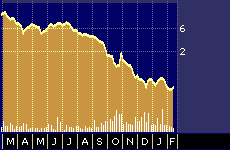
Webvan’s Survival Plan
Webvan’s Survival Plan
By Hal Plotkin
CNBC.com Silicon Valley Correspondent
I t seems hardly a week passes without more bad news from Webvan Group Inc. {WBVN}.
The stock, which is currently trading for less than 35 cents a share, faces potential de-listing from Nasdaq as early as April 12 due to minimum price per share rules. That despite the fact the company still had more than $200 million in cash on hand at the end of December, which makes Webvan one of the most cash-flush companies ever to face the de-listing of its stock.
Seeking to cut costs, the company has announced the closing of operations in its newest market, Dallas, resulting in layoffs of several hundred employees.
Nonetheless, a growing number of analysts are increasingly questioning the viability of the online grocer’s basic business model.
Perhaps the single biggest setback for Webvan investors, though, was the company’s failure to meet its original target of becoming profitable in its first geographic market, the San Francisco Bay Area, in the fifth quarter of operations. The bottom fell out of the already sagging stock when that goal was missed late last year.
Webvan officials are responding to these challenges with a series of countermeasures they say are designed to boost business from repeat customers. The idea, they say, is to fish where the fish are.

One-year performance of WBVN
During the most recent quarter, for example, repeat customers accounted for 86% of the firm’s total orders. The average order size for Webvan’s year-ending quarter was also up, hitting almost $112, representing an increase of 9% over the $103 reported three months earlier. But dig a little deeper and you discover that the company’s core repeat customers are placing, on average, just 3.4 orders per quarter.
“We know our customers are buying a lot more groceries than that,” says Doug Herrington, Webvan’s vice president of marketing. “So we’re making a concerted effort now to build more frequency.”
CNBC.com: Webvan’s Days Appear Numbered

Webvan’s new initiatives include more careful targeting of advertising to consumers who are too busy to shop at conventional stores, reserved and preferred delivery times for repeat customers, and the introduction of a series of different frequent shopper bonus programs similar to the frequent flyer programs used by airlines. The company’s fate may well hinge on the success of those efforts.
Earlier this week, Webvan’s chairman and CEO George T. Shaheen granted CNBC.com an exclusive interview to review the challenges facing the company — and its shareholders.
CNBC.com: When Webvan was introduced to investors the stated goal was to become profitable in the 5th quarter in each market in which you operate. Missing that goal in your first market in the San Francisco Bay Area led to a rapid sell-off of your stock. Was the 5th quarter goal too ambitious or imprudently set?
SHAHEEN: I joined the company just before the (IPO) road show and I don’t remember being prepped on the 5th quarter profitability target. But it is something that came out during the road show. And Wall Street loves to be tethered to something as definitive as that. I think it has not served the company well to throw that out there because in retrospect I don’t think there was any basis to say that, except in a model sense. In retrospect it was a metric that has not served the company well because we continue to learn and revamp the model, and we’re not there yet. So I don’t think it served the company well.
CNBC.com: You’ve recently initiated a series of measures designed to increase the frequency of purchases from your most loyal customers. How long will it take for those efforts to show up on the bottom line?
SHAHEEN: We believe we can see the positive impact of that fairly quickly. The question is when do the results from all that get to the point where you have the demand, the increased order size, the margins, to be profitable – but I’m not going to go out on that limb again. The reality is that many of the companies in this e-commerce space were built with the idea that, if you build it, they will come. I personally believe that that is true – but over time. In the shorter and more intermediate time frame, it will not reach mass-market dimensions, at least not at the get-go.
CNBC.com: But can you get there with your stock trading at current levels?
SHAHEEN

George T. Shaheen
George T. Shaheen:I look at the stock price and I could just cry. It’s very hard to for me to look at the stock price and try to explain it. The bottom really fell out of us on that and I don’t think it’s all of our own doing. Right now we’re a thirty-five cent stock. It doesn’t feel like we’re a thirty-five cent stock. But that’s what the market is telling us. We’re doing the things that I thought would be the hardest, delivering on the service, incredibly well. In terms of holding investor confidence, though, our timing couldn’t be worse to go out and try to hold this confidence at a time when the whole dot com fever is gone. I don’t know what to do about that, other than to continue to improve our model.
CNBC.com: One key to regaining investor confidence would be breaking even in your initial San Francisco Bay Area market. Any update on when that might happen?
SHAHEEN: We have not given a revised statement on that. I would like to believe that we could reach it in the second or third quarter of this year. But all that depends upon demand and shopping habits. We’re very pleased with our growing order size, we’re very pleased with our increasing gross margins, and we’re very pleased with our inventory turns. So we think we’re making some very good progress toward our goals.
CNBC.com: In the meantime, though, Webvan’s stock faces potential de-listing from Nasdaq in late April if your stock continues to trade below $1 a share. What, if anything, can you do to prevent that?
SHAHEEN: There are only a few things we can do from our perspective. We can go to the Nasdaq and make the case as clearly and strongly as we can that one of their metrics should not lead to de-listing of the company when the other metrics are inline. That’s something we can do through their appeals process. Secondly, we can execute the business model and meet some of these objectives that we’re going after, and hopefully that will take the investor interest to the point where they will move our stock up. The third alternative we have is to do a reverse stock-split. But I don’t think a reverse stock split is a path to be pursued.
CNBC.com: Would de-listing from Nasdaq be fatal to Webvan?
SHAHEEN: It’s not fatal. The reason you go public is to have a forum where you can raise additional capital. We do not foresee ourselves, given our circumstances, going after additional capital through the public markets. So from that point of view we’re not losing anything. Still, it’s very difficult to make a market in your stock going forward because you’re off the pink sheets.
CNBC.com: Are you giving any consideration to the idea of a merger, or perhaps selling the company or divesting its assets in some other way?
SHAHEEN: I don’t think we’re necessarily stuck in the mud on being an independent, pure Internet company. So we’re open to anything that would make sense. In my mind it would not be another delivery service, though, and it probably wouldn’t be another Internet company. It would be more likely to hook up, if at all, with an appropriate brick and mortar retailer. We don’t currently have anything in the works on that. But we’re not opposed to it.
CNBC.com: Many say Webvan’s future depends on changing shopping habits and that changing consumer habits is a very difficult task. How can Webvan surmount that problem in a short time frame?
SHAHEEN: Changing shopping habits is job one. That’s what its all about. Anytime a consumer switches to us it means a change in their basic [shopping] habits. But if you go back and look at retail cycles in this country you saw it went from the peddler, to the general store, to the sole proprietor, to the supermarket, to the discount store, to the hypermarket. We’ve seen these paths to the consumer form and develop every economic cycle in this country and around the world. So I don’t think that is all that impossible to think through. We’ve got another thing happening, too. [The Internet generation] is coming along, they’ve grown up on technology, and in three to five years they are coming into their disposable income years and they need Webvan because they are totally focused on a different lifestyle. There’s going to be an onslaught of these buyers, they are going to demand to shop this way, and they are going to seek out and support services like this.
CNBC.com: What do you most want to say to your shareholders and customers?
SHAHEEN: The message to shareholders is we owe them something. I want to tell them [customers and potential customers] to come in and use us, to allow themselves the freedom of changing their habits. Work with us. Let us give you your time back. That’s the single message I’d most like to get across.


